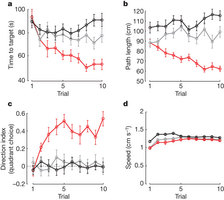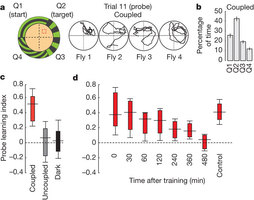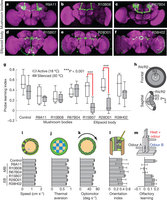摘要:蚂蚁或蜜蜂等昆虫以其导航能力而出名,这种能力部分是由于它们能够学习视觉提示并将其与空间中的位置关联起来。现在,Charles Zuker及其同事发现,作为一种强大遗传模型生物的果蝇也能够利用视觉来形成空间记忆。通过遗传手段使特定神经元沉寂,他们又发现,这样的空间学习依赖于脑中一个区域(椭圆体),这个区域与用于非空间学习的区域(蘑菇体)不是一个地方。这项工作有可能使果蝇成为空间记忆研究中一个首选模型。

llustration of the arena. The floor is composed of 64 thermoelectric modules (a Peltier array)

Flies were trained with a coupled visual panorama (red; n = 33 experiments, 495 flies),

Flies are tested in a probe trial (trail 11)

GAL4 driver lines targeting subsets of cells in the mushroom bodies
生物探索推荐英文摘要:
doi:10.1038/nature10131
Visual place learning in Drosophila melanogaster
Abstract:The ability of insects to learn and navigate to specific locations in the environment has fascinated naturalists for decades. The impressive navigational abilities of ants, bees, wasps and other insects demonstrate that insects are capable of visual place learning1, 2, 3, 4, but little is known about the underlying neural circuits that mediate these behaviours. Drosophila melanogaster (common fruit fly) is a powerful model organism for dissecting the neural circuitry underlying complex behaviours, from sensory perception to learning and memory. Drosophila can identify and remember visual features such as size, colour and contour orientation5, 6. However, the extent to which they use vision to recall specific locations remains unclear. Here we describe a visual place learning platform and demonstrate that Drosophila are capable of forming and retaining visual place memories to guide selective navigation. By targeted genetic silencing of small subsets of cells in the Drosophila brain, we show that neurons in the ellipsoid body, but not in the mushroom bodies, are necessary for visual place learning. Together, these studies reveal distinct neuroanatomical substrates for spatial versus non-spatial learning, and establish Drosophila as a powerful model for the study of spatial memories.







